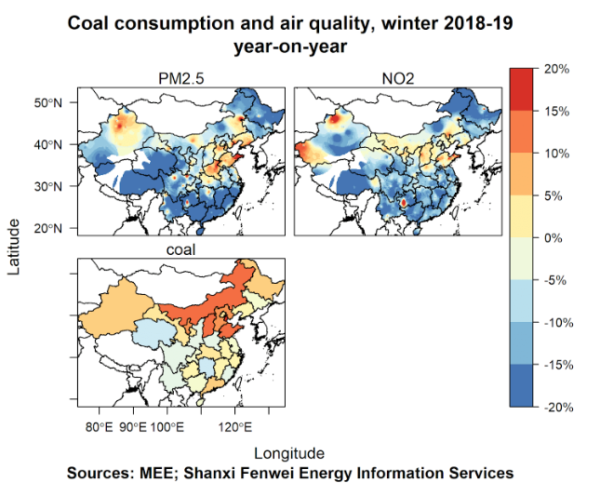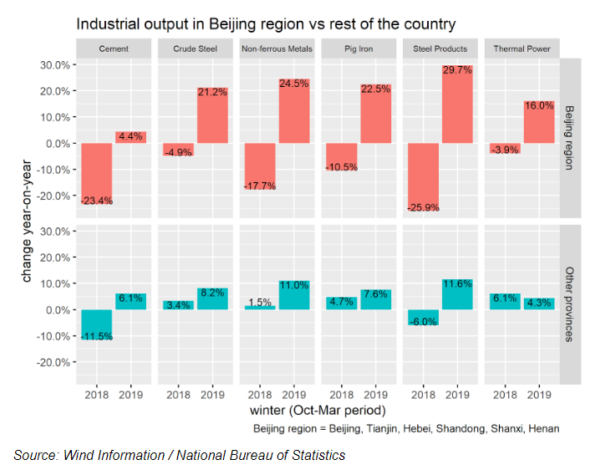Air pollution around Beijing rebounds as coal consumption rises by 13%
Air pollution levels increased in the region - which spans Beijing, Tianjin and 26 surrounding cities - by 6.5% vs the previous year between the months of October and March, when the government’s winter air pollution action plan was in force

Air quality in the region around Beijing deteriorated as coal consumption increased during the past winter, according to analysis of government data by the Greenpeace Air Pollution Unit.
However, PM2.5 concentrations continued to fall nationwide, achieving a reduction of 9.2% over the same period.
Air pollution levels increased in the region – which spans Beijing, Tianjin and 26 surrounding cities – by 6.5% vs the previous year between the months of October and March, when the government’s winter air pollution action plan was in force.
Only four out of the 28 cities met their smog reduction targets, as shown by official data released by Ministry of Ecology and Environment. The number of heavily polluted days increased by 37%.

Missed targets
The region had a target of reducing PM2.5 pollution levels and number of heavily polluted days by 3%. The target was determined by the central government, but in a departure from the previous winter, it seems that local governments were given wide berth in deciding and implementing the measures to meet this target.
Predictably, local governments did away with restrictions on industrial operation that had squeezed output and emissions in 2017-18. Production of steel products plummeted 26%, non-ferrous metals 18%, cement 23% and thermal power 4% in winter 2017-18, only to rebound 30%, 25%, 4% and 16% during the past winter.
As a result, coal consumption increased by 13% in the six provinces included in the air pollution control region, buoyed by demand from power plants and metals industry, based on proprietary data from Fenwei Energy Information.
The 6 provinces around Beijing burn about 1,200 million tonnes of coal, 30% of the national total and more than the EU and the U.S. put together. The increase from winter 2017-18 to 2018-19, about 60 million tonnes, is more than Poland’s total consumption over the same period.

Better Beijing
Beijing itself achieved a 2% year on year decline in PM2.5 during this time, which was reached despite less favorable weather conditions than the previous year and a relaxation of industrial output restrictions. In the region as a whole, weather conditions remained much more favorable than during the most polluted winter seasons, but not as good as previous winter which saw strong winds from the northern grasslands for much of the winter. Less favorable weather conditions account for a part of the rebound in pollution levels, but even accounting for weather there was little to no progress.
Major improvements were seen in a number of southern provinces where thermal power generation fell and heavy industry output cooled, compounding the effects of air quality policies. PM2.5 levels fell by over 20% in Guangdong and Guangxi and over 10% in neighboring Fujian and Hunan.
Coal consumption outside the provinces that are a part of the Beijing air pollution control area increased by 3% over the same period, slowing to zero growth on the first quarter.
For the past two years, environmental regulators have expended heroic efforts to keep air pollution levels falling while industrial output and coal consumption climb. As PM2.5 pollution tends to peak in the winter, they have also pushed industrial output to summer months, contributing to worsening summertime ozone episodes.
This winter’s defeat in key northern China cities suggests that it is getting harder and harder to maintain air quality improvements unless coal consumption starts falling again.
China’s record improvements in air quality since 2012 have shown how enforcing strong emissions standards and shifting away from coal can reduce pollution and save lives. The next step is long-term planning away from coal and heavy industry. Future air quality gains are dependent on successfully reducing reliance on coal through accelerated clean energy investment and by setting strong coal reduction targets in energy plans and targets beyond 2020.

